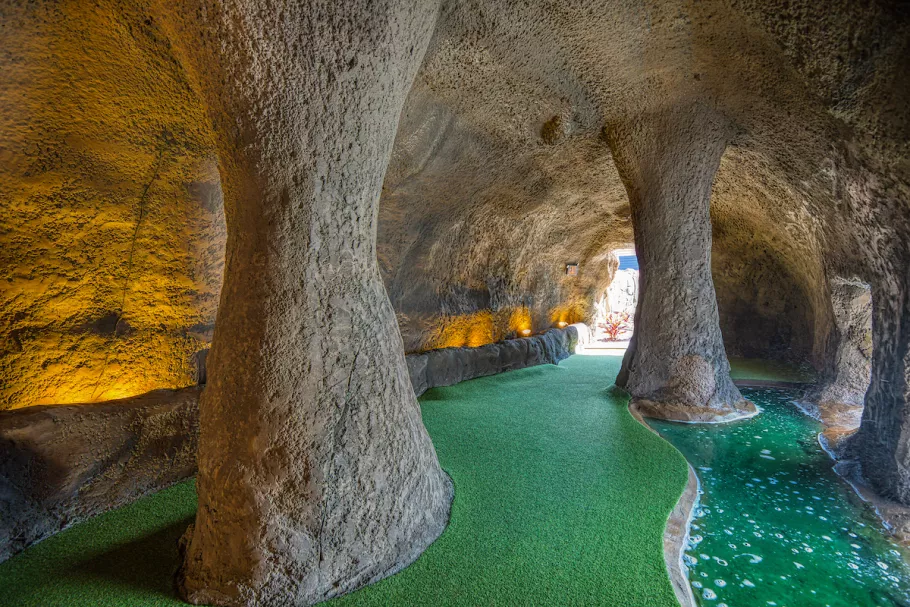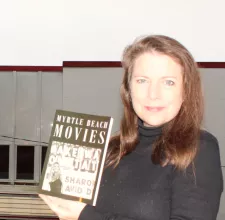Discover Myrtle Beach’s Newest Miniature Golf Course: Red Dragon Cove

Adventure Awaits in the Mini Golf Capital of the World
It’s been a long time since a new miniature golf course has opened along the Grand Strand and the latest addition does not disappoint. Red Dragon Cove is located on the corner of Kings Highway (Highway 17 Business) and 20th Avenue South. It has all of the elements that one comes to expect from a Myrtle Beach putt putt course but elevates the genre with its architecture and outdoor décor.

Myrtle Beach miniature golf is not a subject that I take lightly. Not only did I grow up here playing mini golf, but I also grew up in the sport’s Golden Era; at least that’s what I call it. Miniature golf came to this country in the 1920s and was a popular fad, but the Great Depression pretty much quashed that in the 1930s, followed by World War II in the 40s. But the game had a resurgence in the 1950s and has maintained its popularity ever since.
Myrtle Beach’s first course, according to a local history book in my personal collection, was constructed on the corner of Kings Highway and 9th Avenue North. Apparently, it went the way of the nation’s other courses at that time and closed. I’ve never seen a photo of it or have happened upon another reference about it.
Then, also following our country’s trend, I do know of one that was constructed here in 1953. Inspired by a course that he saw in Boston, Justin Plyler who was the founder of The Gay Dolphin Gift Cove and proprietor of a colorful array of mid twentieth century tourist attractions, converted a parking lot into a miniature golf course. It was across the street from his store that still stands tall on North Ocean Boulevard today near Plyler Park (named for Justin).
His son, Buz, was four at the time. Four years later, Buz began his professional career working at that course. Child labor laws don’t apply to work done for your family, on a farm or in the entertainment industry. I began receiving my first paychecks from my dad working in his veterinary hospital the summer I was nine. Most of the kids whom I grew up with in Myrtle Beach worked in their family's businesses. When we turned 16, we could work in other businesses.
Buz doesn’t recall that there were any other courses around in 1953 although there could have been. He does remember that there had been at least that one that ultimately closed. If they weren’t in existence at that time, they certainly followed, and Myrtle Beach has had various traditional courses to choose from ever since.
One of the chief engines behind their creation was the Burroughs and Chapin Company, known earlier as the Myrtle Beach Farms Company. It was founded in 1912 by Milwaukee native, Simeon B. Chapin, and the sons of local visionary, Franklin G. Burroughs. The person we would refer to today as their Chief Operating Officer was a gentleman by the name of James Bryan. It would be his grandson, James “Poddy” Bryan, whom Sports Illustrated would dub The Father of Modern Miniature Golf.
That title was earned throughout his career that stretched from the 1960s until his death in 2002. He was an educator who happened to design mini golf courses, but it was the latter effort that is his legacy. It is said that he designed about 20 golf courses along the Grand Strand, most of which are still here. Then he went on to create approximately 230 around the US.
The Golden Era that I mentioned earlier is simply the time that spanned Poddy’s career. His work was transformative.
One of the first courses he did for Burroughs and Chapin had a jungle theme and was very much like other carpet golf courses of the late 1960s. Everything changed shortly thereafter when he began to design a course that would take you around the world, so to speak, in 18 holes. Each hole would depict a different international location. A colleague who worked with him said that it was on that project that it occurred to Poddy that courses didn’t have to be entirely flat. Why not build a mountain at the hole depicting Tibet? So they did. The rest is history.
With a few exceptions, you can’t have a Myrtle Beach mini golf course without a mountain, waterfall, cave system and a theme. Putt putt is fun, but along the Grand Strand it is taken to the next level…literally. You will climb steps, enter caves, and fish your ball out of the whirling waters of a waterfall if you miss your mark on the green. Fortunately, grates are hidden within the tidal pools and your ball doesn’t get washed away entirely midway through your game.
But you aren’t just on a miniaturized golf course, you find yourself in a narrative. Each hole that you conquer allows you to progress through whatever storyline your course offers. It can be something familiar like the tale of Peter Pan or fairly generic like a jungle or lagoon course, or something fabricated in great detail for your particular experience.
Poddy’s final and favorite course, Mount Atlanticus Minotaur Goff, spins a wild tale borrowing from several myths that one blogger referred to as being “more complex than Tolkien [author of The Hobbit and The Lord of the Rings].” Poddy secured his legendary status in the field when he spent the night in a tiki hut at the top of that course, five stories up, just before its completion during a minor hurricane to prove its durability.
Most of the courses that are enjoyed today were constructed during that Golden Era. If they weren’t made by Poddy, they were certainly influenced by his work both in the overall design of a property, and in the details of how the holes are executed. There were certain ways that balls would need to be banked off of a two by four. Or you would have to get the ball in one of several holes at the top of an elevation so that it would end up nearest the actual hole when you walked down the steps to the green to see if the PVC pipe that your ball went into was the most advantageous.
It was with the memory of Poddy’s legacy very much on my mind that I visited Red Dragon Cove. I dare say that I think that he would have been pleased with it. All of the boxes are checked for elevations (It even has a swinging rope bridge.), caves and beautiful waterfalls that all tie into a yarn about a pirate queen who travels from one adventure to the next throughout Asia.
I scrutinized the logistics of every hole. There were some that reminded me of those that I tackled in my childhood. Then there were those that had elements that I had never seen before. It was challenging, but fun. It is everything that Myrtle Beach miniature golf should be.
But what makes it even more special is that it brings an element of elegance that has not been seen in putt putt. You enter through a temple that is aesthetically impressive. Throughout the course there are lovely sculptures and landscaping. And the red-sailed pirate ship in the front lagoon is striking.
But aesthetics aside, families, couples, and friends go to such a course for a good time. And that is what they are going to have. It’s been ages since my husband and I went putt-putting and we just had the best time. Not only did we enjoy ourselves in the moment, playing there tapped all of those childhood memories with friends and family that made growing up in Myrtle Beach so special.
